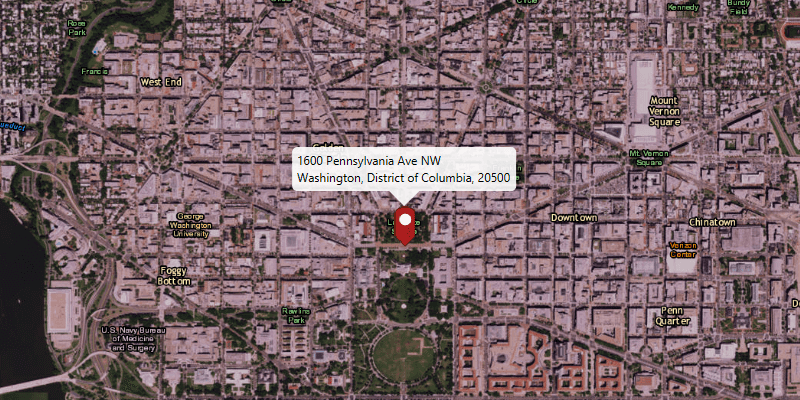Use an online service to find the address for a point on the map.

Use case
You might use a geocoder to find a customer's delivery address based on the location returned by their device's GPS.
How to use the sample
Click on the map to see the nearest address displayed in a callout.
How it works
- Create a
LocatorTaskobject using a URL to a geocoder service. - Set the
GeocodeParametersfor theLocatorTaskand specify the geocoder's attributes. - Get the matching results from the
GeocodeResultusingLocatorTask.reverseGeocodeAsync. - Show the results using a
PictureMarkerSymboland add the symbol to aGraphicin theGraphicsOverlay.
Relevant API
- GeocodeParameters
- LocatorTask
- ReverseGeocodeParameters
Additional information
This sample uses the World Geocoding Service. For more information, see the Geocoding service help topic on the ArcGIS REST APIs website.
Tags
address, geocode, locate, reverse geocode, search
Sample Code
ReverseGeocodeOnlineSample.java
/*
* Copyright 2017 Esri.
*
* Licensed under the Apache License, Version 2.0 (the "License"); you may not
* use this file except in compliance with the License. You may obtain a copy of
* the License at
*
* http://www.apache.org/licenses/LICENSE-2.0
*
* Unless required by applicable law or agreed to in writing, software
* distributed under the License is distributed on an "AS IS" BASIS, WITHOUT
* WARRANTIES OR CONDITIONS OF ANY KIND, either express or implied. See the
* License for the specific language governing permissions and limitations under
* the License.
*/
package com.esri.samples.reverse_geocode_online;
import java.util.HashMap;
import java.util.List;
import javafx.application.Application;
import javafx.application.Platform;
import javafx.geometry.Point2D;
import javafx.geometry.Pos;
import javafx.scene.Scene;
import javafx.scene.control.Alert;
import javafx.scene.control.ProgressIndicator;
import javafx.scene.image.Image;
import javafx.scene.input.MouseButton;
import javafx.scene.layout.StackPane;
import javafx.stage.Stage;
import javafx.util.Duration;
import com.esri.arcgisruntime.ArcGISRuntimeEnvironment;
import com.esri.arcgisruntime.concurrent.ListenableFuture;
import com.esri.arcgisruntime.geometry.Point;
import com.esri.arcgisruntime.mapping.ArcGISMap;
import com.esri.arcgisruntime.mapping.BasemapStyle;
import com.esri.arcgisruntime.mapping.Viewpoint;
import com.esri.arcgisruntime.mapping.view.Callout;
import com.esri.arcgisruntime.mapping.view.Callout.LeaderPosition;
import com.esri.arcgisruntime.mapping.view.Graphic;
import com.esri.arcgisruntime.mapping.view.GraphicsOverlay;
import com.esri.arcgisruntime.mapping.view.MapView;
import com.esri.arcgisruntime.symbology.PictureMarkerSymbol;
import com.esri.arcgisruntime.tasks.geocode.GeocodeResult;
import com.esri.arcgisruntime.tasks.geocode.LocatorTask;
import com.esri.arcgisruntime.tasks.geocode.ReverseGeocodeParameters;
public class ReverseGeocodeOnlineSample extends Application {
private MapView mapView;
private LocatorTask locatorTask;
private GraphicsOverlay graphicsOverlay;
private PictureMarkerSymbol pinSymbol;
private ProgressIndicator progressIndicator;
@Override
public void start(Stage stage) {
try {
// create stack pane and application scene
StackPane stackPane = new StackPane();
Scene scene = new Scene(stackPane);
// set title, size, and add scene to stage
stage.setTitle("Reverse Geocode Online Sample");
stage.setWidth(800);
stage.setHeight(700);
stage.setScene(scene);
stage.show();
// authentication with an API key or named user is required to access basemaps and other location services
String yourAPIKey = System.getProperty("apiKey");
ArcGISRuntimeEnvironment.setApiKey(yourAPIKey);
// add a progress indicator
progressIndicator = new ProgressIndicator(ProgressIndicator.INDETERMINATE_PROGRESS);
progressIndicator.setMaxSize(40, 40);
progressIndicator.setStyle("-fx-progress-color: white;");
progressIndicator.setVisible(false);
// create a map with the imagery basemap style
ArcGISMap map = new ArcGISMap(BasemapStyle.ARCGIS_IMAGERY);
// create a map view and set the map to it
mapView = new MapView();
mapView.setMap(map);
// set a viewpoint on the map view
mapView.setViewpoint(new Viewpoint(40, -95, 36978595));
// add a graphics overlay
graphicsOverlay = new GraphicsOverlay();
mapView.getGraphicsOverlays().add(graphicsOverlay);
// set the callout's default style
Callout callout = mapView.getCallout();
callout.setLeaderPosition(LeaderPosition.BOTTOM);
// create a locator task
locatorTask = new LocatorTask("https://geocode-api.arcgis.com/arcgis/rest/services/World/GeocodeServer");
// create geocode task parameters
ReverseGeocodeParameters reverseGeocodeParameters = new ReverseGeocodeParameters();
reverseGeocodeParameters.setOutputSpatialReference(mapView.getSpatialReference());
// create a pin graphic
Image img = new Image(getClass().getResourceAsStream("/pin.png"), 0, 80, true, true);
pinSymbol = new PictureMarkerSymbol(img);
pinSymbol.loadAsync();
// get geocode on click
mapView.setOnMouseClicked(evt -> {
// check that the primary mouse button was clicked and user is not
// panning
if (evt.isStillSincePress() && evt.getButton() == MouseButton.PRIMARY) {
// create a point from where the user clicked
Point2D point = new Point2D(evt.getX(), evt.getY());
// create a map point from a point
Point mapPoint = mapView.screenToLocation(point);
// show progress indicator
progressIndicator.setVisible(true);
// run the locator geocode task
ListenableFuture<List<GeocodeResult>> results = locatorTask.reverseGeocodeAsync(mapPoint,
reverseGeocodeParameters);
// add a listener to display the result when loaded
results.addDoneListener(() -> {
try {
List<GeocodeResult> geocodes = results.get();
if (geocodes.size() > 0) {
// get the top result
GeocodeResult geocode = geocodes.get(0);
// set the viewpoint to the marker
Point location = geocode.getDisplayLocation();
mapView.setViewpointCenterAsync(location);
// get attributes from the result for the callout
String address = geocode.getAttributes().get("Match_addr").toString();
HashMap<String, Object> attributes = new HashMap<>();
attributes.put("title", address.split(",")[0]);
attributes.put("detail", address.substring(address.indexOf(", ") + 2));
// create the marker
Graphic marker = new Graphic(geocode.getDisplayLocation(), attributes, pinSymbol);
// update the marker
Platform.runLater(() -> {
// clear out previous results
graphicsOverlay.getGraphics().clear();
// add the marker to the graphics overlay
graphicsOverlay.getGraphics().add(marker);
// stop the progress indicator
progressIndicator.setVisible(false);
// display the callout
callout.setTitle(marker.getAttributes().get("title").toString());
callout.setDetail(marker.getAttributes().get("detail").toString());
callout.showCalloutAt(location, new Point2D(0, -24), Duration.ZERO);
});
}
} catch (Exception e) {
// handle address not found
progressIndicator.setVisible(false);
Platform.runLater(() -> {
Alert alert = new Alert(Alert.AlertType.INFORMATION);
alert.setHeaderText(null);
alert.setContentText("No address found at this location");
alert.showAndWait();
});
}
});
}
});
// add map view and control panel to stack pane
stackPane.getChildren().addAll(mapView, progressIndicator);
StackPane.setAlignment(progressIndicator, Pos.BOTTOM_LEFT);
} catch (Exception e) {
// on any error, print the stack trace
e.printStackTrace();
}
}
/**
* Stops and releases all resources used in application.
*/
@Override
public void stop() {
// release resources when the application closes
if (mapView != null) {
mapView.dispose();
}
}
/**
* Opens and runs application.
*
* @param args arguments passed to this application
*/
public static void main(String[] args) {
Application.launch(args);
}
}